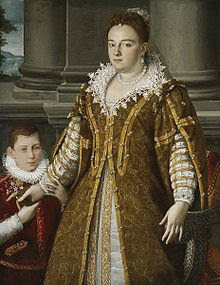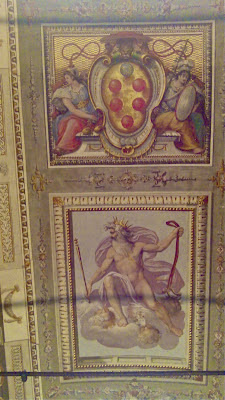 |
| Ceiling of the BNL bank in via Cavour 59, once part of the casino of Don Carlo de Medici. The ceiling decoration is from one of the two rooms dedicated to this brother, Grand duke Cosimo II. |
In Florence a palazzo is the urban dwelling (what in Venice is referred to as a Ca’) mixing business and domestic spaces and a villa is located outside of the city’s walls in the country. A casino, however, is an urban villa. It is a space where entertainment, entertaining, hobbies and more intimate meetings may take place, usually with a garden and the piano nobile (the most important level, usually on the first floor in a palazzo, is on the ground floor as no business takes place in a casino). They are typically located on the outer perimeter of the city closer to the city’s walls than in the heart of the centre.
The Medici casino is located in the area of San Marco, just beyond the eponymous piazza, which was a stone’s throw away from the city’s limits. The land of the Medici casino was first acquired by Ottaviano de’ Medici during the reign of Cosimo I de Medici, the first Grand duke of Tuscany, in the middle of the 1500s. Ottaviano, in need of cash, conceded the land and buildings to Cosimo I, who in turn, gave it to his first born son and heir, Francesco. It is with Francesco that the history of the Medici casino of San Marco really begins to become interesting, and the building starts to take the form that we see today.
 |
| Casino di San Marco as seen from via Cavour |
 |
| Close up of the window by Bernardo Buontalenti |
Francesco, so different from his father, the master political statesman, was disinterested in ruling the Granduchy that his father had created, and he left that task to a body of advisors and administrators, which would have made his father turn in his grave if he had known. Francesco was much more taken with trying to discover the formula to understanding all knowledge, and was one of the most well known alchemic princes in Europe in the second half of the sixteenth century. He surrounded himself with some of the greatest herbalists, scientists, experimentalists, pharmacists, glass makers and stone cutters of his day and provided all that they needed in the Casino di San Marco, which he had built by his friend and trusted architect the ingenius Bernardo Buontalenti in the years 1570-74, in order for them to conduct experiments and further their research in the world around us.
 |
| Portrait of Grand Duke Francesco de Medici (bottom right) in the Alchemist's workshop, Giovanni Stradano (aka: Jan Van der Straet), 1570s. This painting was part of the complex decorative cycle in Francesco's Studiolo inside the Palazzo Vecchio. |
After his death, the Casino di San Marco was passed to his son of his second marriage and to the beautiful, but deathly unpopular Venetian, Bianca Cappello. Not only had his second marriage to Bianca, his longstanding mistress, been distasteful to most in the Florentine court, it was widely speculated that Don Antonio, their son, was not Francesco’s son at all. After the death of Francesco and Bianca (within one day of each other), Ferdinando, Francesco’s brother, became Grand Duke and Don Antonio was ousted from any question of succession.
 |
| The second wife of Grand duke Francesco I, Bianca Cappello, and their son, Don Antonio, by Alessandro Allori |
He was compensated with the inheritance of his beloved father’s magical den. Don Antonio de Medici grew up to be a very cultured and erudite man and though he wasn’t interested in practising any of the fine or mechanical arts like his father, he gathered at the Casino a formidable scientific library and art collection. He moved into the casino in 1597 and commissioned a series of renovations. The casino was frequented by a circle of intellectuals and the library was open to scholars. There was even a little theatre. After Don Antonio’s death in 1621, the casino passed to the Cardinal Carlo, brother of the Grand duke Cosimo II, who died in the same year leaving his mother, Cristina of Lorraine, and his wife, Maria Maddalena of Austria, as regents of the Grand duchy until his eldest son, eleven year old Ferdinando, was able to take the reins of rule.
Cardinal Carlo, who had probably entertained the idea of being regent of the Grand Duchy, or at least playing a major role in the administration until his nephew came of age, embarked upon a series of decorative renovations on the ground floor rooms. He commissioned some of the best artists of the early 1600s in Tuscany to fresco the elaborate and exquisitely depicted ceiling program which exalted the male line thus far of the Medici Grand dukes.
 |
| The central section of the ceiling of the room dedicateed to the first Grand duke of Tuscany, Cosimo I. He is crowned with the laurel wreath and surrounded by Valour and Fame. |
 |
| The central section of the room dedicated to the Grand Duke Francesco I. |
 |
| One of the three central panels of the room dedicated to Grand duke Ferdinando I - Neptune, in reference to his role in the development of the Livorno port. |
 |
| The central section dedicated to Grand duke Cosimo II. |
One room was dedicated to each grand duke (Cosimo I, Francesco and Ferdinando) and two rooms were dedicated to the recently departed, Cosimo II. In the middle of the ceiling there was a portrait of the ruler and surrounding this, this there was a running decoration of scenes depicting the feats and achievements during their reign, as well as personifications of their virtues and character. The main artists working at the casino for cardinal during the early years of the 1620s were; Matteo Rosselli, Michelangelo Cinganelli, Fabrizio Boschi and Anastasio Fontebuoni, just to name a few.
 |
| Abundance from the room dedicated to Grand duke Francesco I. |
At the same time, the widowed Maria Maddalena of Austria, was renovating her preferred villa, called Poggio Imperiale, a stone’s throw from the city’s walls and a very short carriage ride from the grand ducal residence (Palazzo Pitti). She commissioned a decorative series dedicated to the great women of influence throughout history on the ceilings of the ground floor rooms; saints, queens from antiquity and heroines from the Old Testament dedicated to the rearing of children, to religion and to the state, as allegories and added weight to her current situation. Matteo Rosselli (a collaborator at the casino di San Marco) and his workshop undertook the commission from the Grand duchess.
 |
| Detail of the ceiling in the main room of Poggio Imperiale with the coat of arms of Maria Maddalena of Austria. |
 |
Poggio Imperiale
These two contemporaneous decorative cycles have been closed to public view for a very long time.The Poggio Imperiale villa has been a high school for decades, however, in a few weeks, there will be tours in Italian on Saturday mornings only, something absolutely worth while doing as it is a wonderful experience.
|
The casino of San Marco has been the seat of the court of Appeals for decades, however this is soon to change, as in April it will move out to the Florentine suburb of Novoli (Florence west), where it will be joined by all the other different judicial departments which have been traditionally housed in different structures spread over the city. They will all be housed under the same roof in the same enormous structure, Palazzo di Guistizia, which has been in construction since 2000. The fate of the casino di San Marco has yet to be decided. One of the five rooms (one of the two dedicated to his brother, Cosimo II) commissioned by Cardinal Carlo can be seen by everybody however. This room happens to be part of the building that was rented out to one of the branches of the BNL bank. So pop your head inside the next time that you find yourself walking down the via cavour, as who knows what the fate will be now of this fabulous building with the most fascinating history.
















